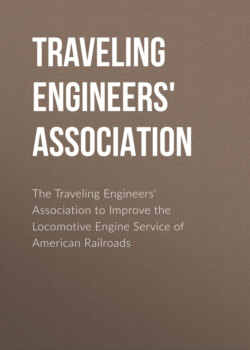Читать книгу The Traveling Engineers' Association to Improve the Locomotive Engine Service of American Railroads - Traveling Engineers' Association - Страница 5
AIR BRAKE QUESTIONS
Оглавление1. Q. What is an air brake?
A. A brake operated by compressed air.
2. Q. How is this air compressed?
A. By an air compressor on the locomotive.
3. Q. Name the different parts of the air brake as applied to the locomotive.
A. The air compressor, compressor governor, automatic and independent brake valves, distributing valve, triple valve, auxiliary reservoir, brake cylinders, main reservoir, air gauges, angle cocks, cut-out cocks and the necessary piping.
4. Q. What is the purpose of the main reservoir?
A. It is used for storing a large volume of air for the purpose of promptly charging and recharging the brakes. Where the engine is equipped with either the E. T. or L. T. type of brakes, main reservoir air is used to supply the air to the brake cylinders on the locomotive.
5. Q. What other appliances use main reservoir air?
A. It is used in the operation of the power reverse gear, sand blower, bell ringer, water scoop, air signal, fire door, water sprinkler and other devices.
6. Q. What does the red hand on each of the air gauges indicate?
A. The red hand on the large gauge indicates main reservoir pressure; on the small gauge, brake cylinder pressure.
7. Q. What does the black hand on each of the air gauges indicate?
A. The black hand on the large gauge indicates the equalizing reservoir pressure; on the small gauge, brake pipe pressure.
8. Q. What pressure is usually carried in the main reservoir?
A. Ninety pounds in freight and 130 pounds in passenger service. But where freight engines are equipped with duplex compressor governor, the low pressure top is adjusted to ninety pounds and the high pressure top to 130 pounds.
9. Q. What pressure is usually carried in the brake pipe?
A. Seventy pounds in freight and 110 pounds in passenger service.
10. Q. What must the air pass through in flowing from the main reservoir to the brake pipe?
A. Through the automatic brake valve.
11. Q. Name the different positions of the automatic brake valve.
A. Release, running, lap, service and emergency positions. The brake valve used with the E. T. and L. T. equipment has still another position known as holding position, which is located between running and lap positions.
12. Q. Name the different positions of the independent brake valve.
A. Release, running, lap, slow application and quick application positions.
13. Q. How many kinds of triple valves are there in use?
A. Two; plain and quick action.
14. Q. How is the automatic brake applied? How released?
A. The automatic brake is applied by a reduction of brake pipe pressure, and is released by restoring the brake pipe pressure.
15. Q. When the independent brake valve handle is placed in application position, are the train brakes affected?
A. No; only the brakes on the locomotive are applied.
16. Q. What controls the pressure in the main reservoir?
A. The compressor governor.
